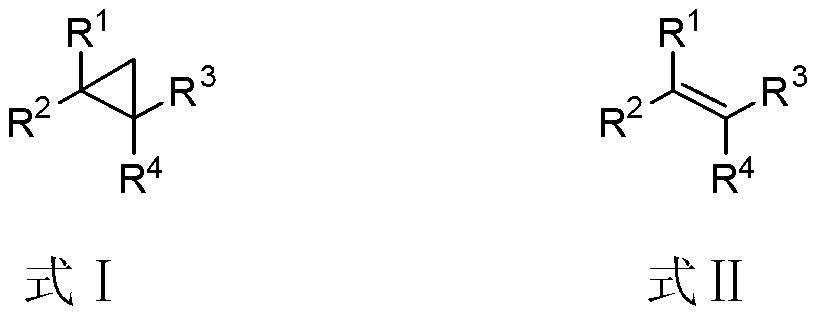Preparation method of cyclopropane compounds
A cyclopropanation and compound technology, which is applied in the field of preparation of cyclopropane compounds, can solve problems such as being not suitable for acid-sensitive compounds, and achieve the effects of large industrialization potential, high yield and wide application range
- Summary
- Abstract
- Description
- Claims
- Application Information
AI Technical Summary
Problems solved by technology
Method used
Image
Examples
Embodiment 1
[0022] Example 1. Synthesis of trans 1-methyl-2-phenylcyclopropane (see structural formula Ⅰ-a)
[0023]
[0024] Under nitrogen at room temperature, freshly distilled dichloromethane (2.0 mL) was added to the schlenk tube, followed by diethylzinc solution (2.0 mL, 2.0 mmol) (1.0 M in hexane). After cooling at -40°C for 5 min, a solution of diiodomethane (1.080 g, 4.0 mmol) in dichloromethane (1.0 mL) was added dropwise to the schlenk tube. After reacting at -40°C for 1h, a solution of trichloroacetic acid (0.0326g, 0.20mmol) and DME (0.090g, 1.0mmol) in dichloromethane (1.0mL) was added to the reaction solution, and the reaction temperature rose to -15°C and stirred at this temperature for 1 h. At -15°C, a solution of olefin (formula II-a) (0.121 g, 1.0 mmol) in dichloromethane (1.0 mL) was added dropwise to the reaction solution. The schlenk tube was then transferred to an oil bath at 25°C for 18h, quenched with 0.1N HCl (10mL), diluted with water (10mL), CH 2 Cl 2 (1...
Embodiment 2
[0026] Example 2. Synthesis of trans (2-phenylcyclopropanyl)-methanol (Formula Ⅰ-b)
[0027]
[0028] Under nitrogen at room temperature, freshly distilled dichloromethane (1.0 mL) was added to the schlenk tube, followed by diethylzinc solution (1.0 mL, 1.0 mmol) (1.0 M in hexane). After cooling at -40°C for 5 min, a solution of diiodomethane (0.540 g, 2.0 mmol) in dichloromethane (0.5 mL) was added dropwise to the schlenk tube. After reacting at -40°C for 1h, a solution of trichloroacetic acid (0.0163g, 0.10mmol) and DME (0.045g, 0.5mmol) in dichloromethane (0.5mL) was added to the reaction solution, and the reaction temperature rose to -15°C and stirred at this temperature for 1 h. At -15°C, a solution of alkene (Formula II-b) (0.069g, 0.5mmol) in dichloromethane (0.5mL) was added dropwise to the reaction solution. Then the schlenk tube was transferred to an oil bath at 25°C for 2 h, and saturated NaHCO 3 solution (5mL) to quench the reaction, stirred at room temperatu...
Embodiment 3
[0030] Example 3. Synthesis of trans 1-[(tert-butyldimethylsilyloxy)methyl]-2-phenylcyclopropane (Formula I-c)
[0031]
[0032]Under nitrogen at room temperature, freshly distilled dichloromethane (1.0 mL) was added to the schlenk tube, followed by diethylzinc solution (1.0 mL, 1.0 mmol) (1.0 M in hexane). After cooling at -40°C for 5 min, a solution of diiodomethane (0.540 g, 2.0 mmol) in dichloromethane (0.5 mL) was added dropwise to the schlenk tube. After reacting at -40°C for 1h, a solution of trichloroacetic acid (0.0163g, 0.10mmol) and DME (0.045g, 0.5mmol) in dichloromethane (0.5mL) was added to the reaction solution, and the reaction temperature rose to -15°C and stirred at this temperature for 1 h. At -15°C, a solution of alkene (Formula II-c) (0.124 g, 0.5 mmol) in dichloromethane (0.5 mL) was added dropwise to the reaction solution. Then the schlenk tube was transferred to an oil bath at 25°C for 18 h, saturated with NH 4 Cl (10 mL) quenched the reaction, CH...
PUM
 Login to View More
Login to View More Abstract
Description
Claims
Application Information
 Login to View More
Login to View More - R&D
- Intellectual Property
- Life Sciences
- Materials
- Tech Scout
- Unparalleled Data Quality
- Higher Quality Content
- 60% Fewer Hallucinations
Browse by: Latest US Patents, China's latest patents, Technical Efficacy Thesaurus, Application Domain, Technology Topic, Popular Technical Reports.
© 2025 PatSnap. All rights reserved.Legal|Privacy policy|Modern Slavery Act Transparency Statement|Sitemap|About US| Contact US: help@patsnap.com



